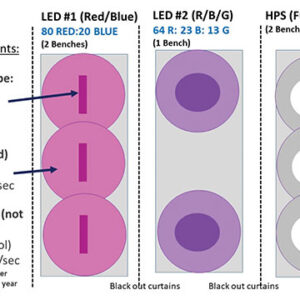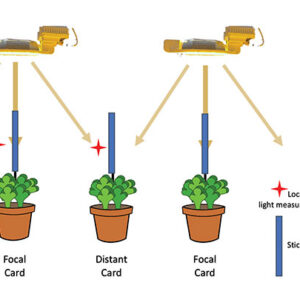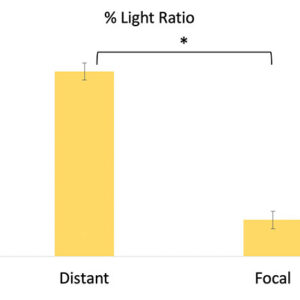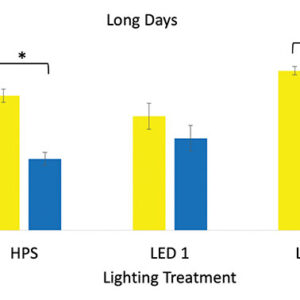
Features
Focus on: Lighting
ILLUMINATING IPM
Study offers further insight on the effect of LEDs on pests
October 16, 2023 By Rebekah Hest, Dr. Sarah Jandricic, and Sophie Krolikowski
 Sticky cards under LED lights in a study looking at the effect of lighting on the behaviour of greenhouse pests.
PHOTO: Dr. Srah Jandricic et al.
Sticky cards under LED lights in a study looking at the effect of lighting on the behaviour of greenhouse pests.
PHOTO: Dr. Srah Jandricic et al. Given the advancements in light technologies, many greenhouses across Canada are converting from conventional lighting to LED light. While the effects of light on crops have been heavily studied, it is important to also explore its effects on pests to update and implement more effective IPM strategies.
A previous article in this magazine has some interesting preliminary results on the effects of LED lights on thrips sticky card colour preference for mass trapping western flower thrips (see What does LED lighting mean for pest monitoring? By Sarah Jandricic, October 2021 edition). Today’s article takes a deeper dive into this question. Here, we explore how LED lighting affects catches of both thrips and fungus gnats, and demonstrate how results can differ depending on the time of year or the light recipe used.
Sticky cards or tape are considered an affordable IPM tool for thrips and other flying pests. These are generally blue or yellow because most insects are attracted to these wavelengths of light. But what happens when the lighting source shines different wavelengths on these cards? Is card colour preference affected?
To begin to understand the effect of light on perception, we conducted a series of trials to determine if sticky cards recommendations (colour, placement) should be changed based on the type of lighting used.
We used chrysanthemums as a model crop: they don’t need supplemental lighting, but they do host a variety of pests. 90 thrips per bench were released into the crop and allowed to reproduce for two weeks. The fungus gnats came free!
Greenhouse set up
- We set up our trials across two research greenhouse compartments at the Vineland Research and Innovation Centre
- Each compartment had three benches filled with vegetative chrysanthemum plants
- Benches received one of three treatments: HPS lights, LED lights from company 1 (80:20 red:blue – LED 1) and LED lights from company 2 (64:23:13 red:blue:green – LED 2) (see Figure 1 for light intensity, recipes and placement).
Black-out curtains were hung between the benches and along walls shared with other greenhouse compartments to prevent interference from other lighting sources, with the exception of natural sunlight from above.
Lighting Trials
We chose to run two different trials at two times of year. The first was done under short days (eight hours of light) in January, when light levels are generally very low. Here, plants were grown under ambient light and supplemental light was given when needed. This reflects how growers are currently using supplemental light in an energy efficient way.
The second experiment was run in late February/early March. Here, we chose to go with ambient light with supplemental light for 24 hours of the day. Why? To try and kill several birds with one stone. Not only does this more closely mimic long-day ornamental production in the winter (~16 hours of light needed), but this also reflects ongoing research into 24-hour lighting regimes in vine crops with lower light intensity. From this point forward, the trials will simply be referred to as “Short Days” and “Long Days” for simplicity’s sake (see table 1 for details).
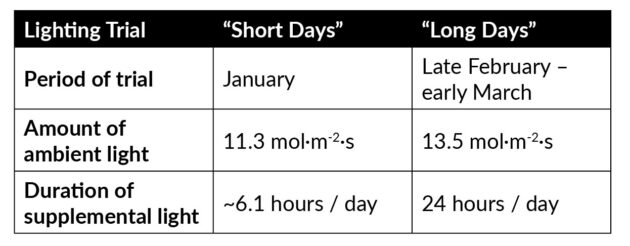
TABLE 1
Details of the lighting measurements taken between the trials.
Pest Monitoring
Twelve pairs of yellow and blue sticky cards were placed both directly under the light (focal zone) and at a distance (bleed zone) on each bench and were collected at various time intervals. Depending on where the sticky card is placed underneath the light source, the colour may appear differently due to the angle of reflection. Most of the red/blue light is hitting on the side of the card in the more distant part of the light cone, so that’s where the colour change is happening. (see Figure 2 for diagram of set up).
Thrips and gnats were counted at a later date and calculations were done to determine the proportion of insects caught on yellow cards versus blue cards under each treatment and at each card location (focal or bleed zone).
Result – Short Days
After all the sticky cards were collected from the different lighting trials, what did we find?
Under HPS lights we saw the thrips behave similarly to previous experiments done under natural light conditions in summer. This was true for both card positions (see Figure 3(A)). Here, yellow is generally preferred over blue at a ratio of around 70:30. This makes sense, as HPS lights are full spectrum, and would more closely mimic sunlight.
However, the story was different under LED lights. Blue cards were preferred for both LED light recipes in the bleed zone (Figure 3, B and C). While there was still a preference of yellow under LED 1 in the focal zone (see Figure 4 for why this happens), light fixtures are generally set up to create as many areas of overlap as possible, to maximize lighting. Thus, the results in the bleed zone are more relevant to commercial greenhouses.
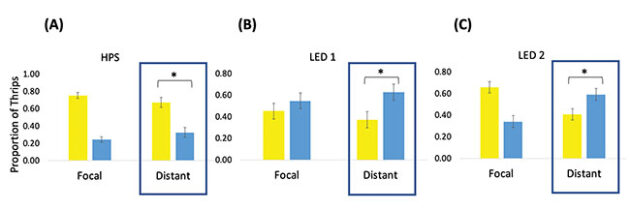
FIGURE 3
Results for the “Short Days” lighting trial comparing lighting types, card placement and colour. An asterisk is used to represent a significant difference and blue boxes were used to highlight the bleed zone results.
Results – Long Days
Here, we only focused on results with cards in the bleed zone, due to reasons explained above. HPS lights performed very similarly under long days as short days. However, to our surprise, the LED lights performed quite differently in this experiment.
The proportion of thrips attracted to cards placed under LED 2 suddenly skewed towards yellow, compared to the results captured under short days. Similarly, under LED 1, there was minimal difference between yellow and blue cards for long days (see Figure 5 – long day graph results graph), compared to the strong preference for blue that was seen under short days.
The differing strength of the results between the two LED types in this trial likely has to do with their light recipes. One recipe has more red (80:20 red:blue) and the other has less red and has the addition of green (64:23:13 red:blue:green). These differences in wavelength ratios likely affect how yellow and blue cards appear to thrips.
Additionally, we suspect that thrips attraction to yellow cards was generally stronger under long days, simply because this experiment was conducted later in the year. Although the difference between 11.3 mol-m-2∙s and 13.5 mol∙m-2∙s of ambient light might not seem like a huge difference, it could have been enough to “override” the effects of the LED lights that were previously seen under short days where the ambient light quality was low.
What about Thrips NUMBERS?
Knowing the preference of thrips for different traps under various lights is all well and good, but growers are also interested in lighting affects thrips numbers. We found that the proportion of the total thrips population was always highest under HPS lights, regardless of supplemental day length. Which is probably not surprising given the heat HPS lights give out (which can speed up thrips development and generation time). However, thrips could also be more attracted to HPS than the LED lights and have gone over or around our blackout curtains. This needs further testing, where heat is somehow controlled for.
Conclusions and takeaways
We found under HPS lighting the thrips consistently preferred yellow over blue, so you know what to expect year-round. However, when using LED lights, the thrips response to sticky card colour seemed to depend on the time of year. In early winter, adding red and blue mixes to the light recipe skews the card preference towards blue for western lower thrips. But in late winter, around mid-February to early March, adding red and blue mixes showed yellow and blue are fairly equal.
Given these results, if the LED lights you’re using have a strong amount of red and blue in them (which is the usual case), then you may want to switch to blue cards from Late December to early March if western flower thrips are your main concern. However, fungus gnats preferred yellow cards under all test conditions, so be sure to stick with yellow if this is your main pest issue.
Our previous research has found that in early spring, ambient light conditions are bright enough so that LED lighting has no effect on thrips regular preference for yellow cards. The only exception to this is in highly overcast periods. Therefore, in late March, it’s best to switch to yellow cards, regardless of your supplemental lighting type.
In summer, thrips fly in from outside, so this is a critical period for mass trapping. Yellow cards should be used in all lighting conditions from April to October. Yellow cards also trap other pests like flying aphids, fungus gnats and whiteflies.
Lastly, if you are using a combination of HPS and LED lights in the same greenhouse (e.g. when switching over light types), you may see some hot spots of thrips under the HPS lights.
As always, with sticky cards, results can vary greatly depending on your greenhouse cover type and your location, as these both affect light quality. It’s always a good idea to test cards in a short, two-week trial in your facility, under your lights, and use your preferred brand of card to find out what’s best for you.
Rebekah Hest was a Research Assistant for the Ontario Ministry of Agriculture, Food and Rural Affairs (OMAFRA) in 2022. Sophie Krolikowski is the Acting Maple, Tree Nut and Agroforestry Specialist at OMAFRA. And both were mentored by Sarah Jandricic, the Greenhouse Floriculture IPM Specialist.
Print this page
